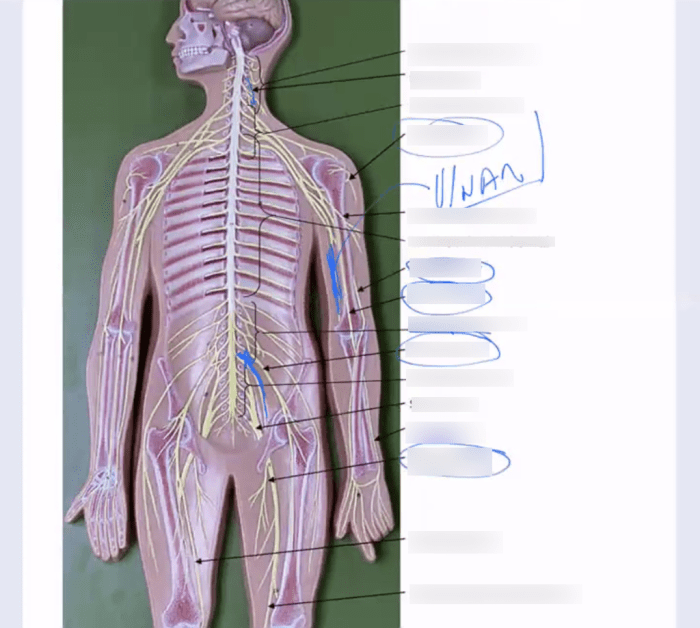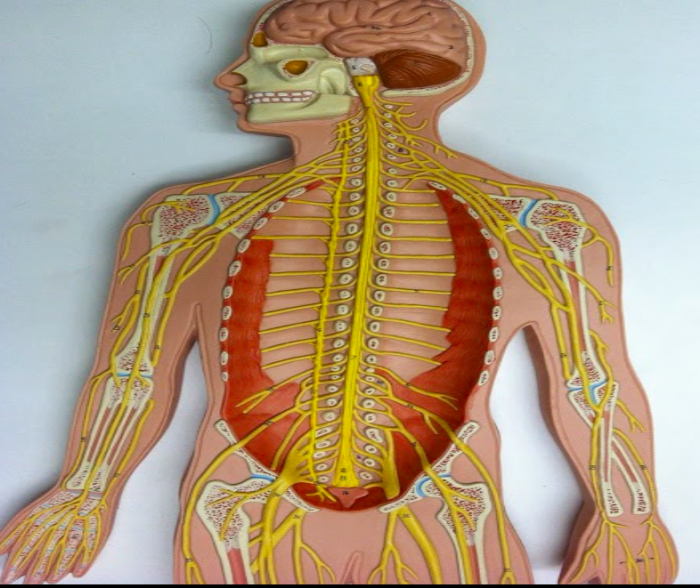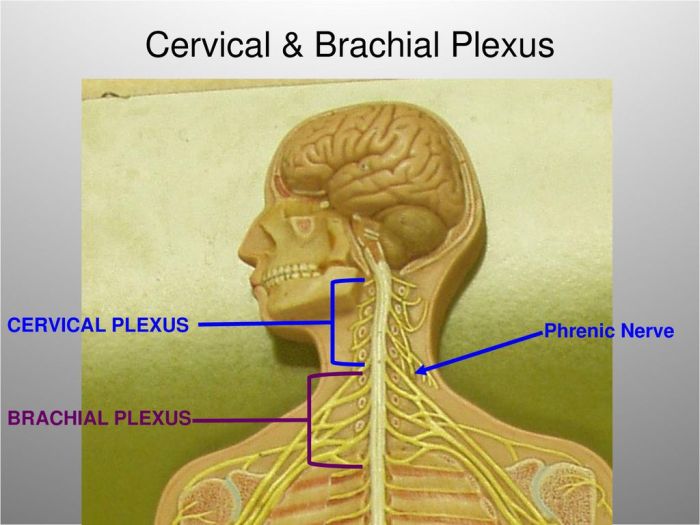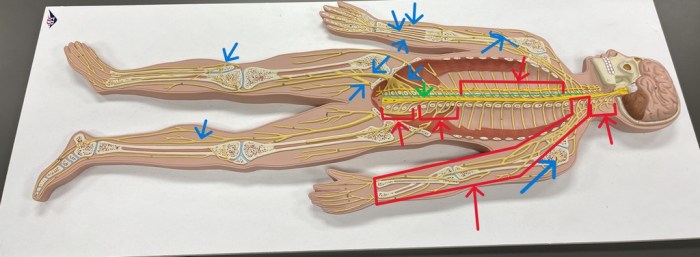The Flat Man Nerve Model Labeled is an invaluable tool for understanding the intricate workings of the human nervous system. This simplified representation provides a clear and concise overview of the major nerve pathways and their organization, making it an ideal resource for students, medical professionals, and anyone interested in the human body.
The model is divided into labeled regions, each representing a specific functional area of the nervous system. Sensory regions receive information from the body’s sensory receptors, while motor regions control movement. Autonomic regions regulate involuntary functions such as breathing and digestion.
Anatomical Structure of the Flat Man Nerve Model

The Flat Man Nerve Model is a simplified representation of the human nervous system. It is used to teach students about the basic structure and function of the nervous system. The model is made up of a flat piece of plastic or cardboard with a series of lines and circles drawn on it.
The lines represent the nerves, and the circles represent the nerve cells.
Major Nerve Pathways
The Flat Man Nerve Model shows the major nerve pathways in the body. These pathways include the:
- Central nervous system (CNS): The CNS consists of the brain and spinal cord. The brain is the control center of the body, and the spinal cord carries messages between the brain and the rest of the body.
- Peripheral nervous system (PNS): The PNS consists of all the nerves that connect the CNS to the rest of the body. The PNS is divided into two parts: the somatic nervous system and the autonomic nervous system.
- Somatic nervous system: The somatic nervous system controls voluntary movements. It is made up of the nerves that connect the brain and spinal cord to the muscles.
- Autonomic nervous system: The autonomic nervous system controls involuntary functions, such as breathing, heart rate, and digestion. It is made up of the nerves that connect the brain and spinal cord to the organs and glands.
Organization of the Nervous System, Flat man nerve model labeled
The nervous system is organized into a hierarchical structure. The brain is at the top of the hierarchy, followed by the spinal cord, and then the peripheral nerves. The brain is responsible for processing information and making decisions. The spinal cord carries messages between the brain and the rest of the body.
The peripheral nerves connect the brain and spinal cord to the muscles, organs, and glands.
Labeled Regions of the Flat Man Nerve Model
The Flat Man Nerve Model is a valuable tool for visualizing and understanding the human nervous system. It features various labeled regions that represent different areas of the nervous system, each with its own functional significance.
Sensory Areas
- Somatic sensory area:This region receives sensory information from the skin, muscles, and joints, such as touch, temperature, and pain.
- Visceral sensory area:This region receives sensory information from internal organs, such as the heart, lungs, and digestive system.
- Special sensory area:This region receives sensory information from the eyes, ears, nose, and tongue, such as vision, hearing, smell, and taste.
Motor Areas
- Somatic motor area:This region controls voluntary movements of skeletal muscles, such as those involved in walking, talking, and writing.
- Visceral motor area:This region controls involuntary movements of smooth muscles and glands, such as those involved in digestion, breathing, and heart rate.
Autonomic Areas
- Sympathetic nervous system:This region prepares the body for “fight or flight” responses, such as increasing heart rate and blood pressure.
- Parasympathetic nervous system:This region promotes “rest and digest” responses, such as slowing heart rate and increasing digestion.
Applications of the Flat Man Nerve Model

The Flat Man Nerve Model serves as an invaluable tool in both educational and clinical settings, offering a tangible representation of the complex human nervous system. Its applications extend across various domains, including teaching neuroanatomy, diagnosing nerve injuries, and planning surgical interventions.
Educational Applications
- Teaching Neuroanatomy:The Flat Man Nerve Model provides a simplified and interactive way to teach neuroanatomy. Students can trace the intricate pathways of nerves, observe their relationships with surrounding structures, and gain a deeper understanding of the nervous system’s organization and function.
- Visual Aid for Lectures:The model serves as a compelling visual aid during lectures, allowing educators to demonstrate anatomical concepts in a tangible and engaging manner. By manipulating the model, students can visualize the three-dimensional relationships between nerves, muscles, and other structures.
- Clinical Applications
- Diagnosing Nerve Injuries:The Flat Man Nerve Model assists healthcare professionals in diagnosing nerve injuries. By comparing the model’s normal anatomy with a patient’s examination findings, clinicians can identify the location and extent of nerve damage, facilitating accurate diagnosis and treatment planning.
- Planning Surgical Interventions:The model aids in planning surgical interventions by providing a detailed roadmap of the nervous system. Surgeons can use it to visualize the target area, anticipate potential complications, and optimize surgical approaches to minimize nerve damage.
Advantages and Limitations of the Flat Man Nerve Model: Flat Man Nerve Model Labeled

The Flat Man Nerve Model offers several advantages, making it a valuable tool for education and research. Its simplicity and visual clarity allow for easy comprehension of the human nervous system. The two-dimensional representation provides a clear overview of the nerves’ distribution and connections.
However, the model also has limitations, primarily due to its two-dimensional nature and lack of depth perception.
Advantages of the Flat Man Nerve Model
-
-*Simplicity and Visual Clarity
The Flat Man Nerve Model simplifies the complex anatomy of the nervous system, making it accessible to students and professionals alike. The two-dimensional representation provides a clear visual representation of the nerves’ distribution and connections.
-*Educational Value
The model is widely used in educational settings to teach the anatomy and physiology of the nervous system. Its simplicity allows students to easily understand the organization and function of the nerves.
-*Research Applications
The Flat Man Nerve Model can be used in research to study the effects of various factors on the nervous system. For example, it can be used to investigate the effects of injuries, diseases, or treatments on nerve function.
Limitations of the Flat Man Nerve Model
-
-*Two-Dimensional Representation
The model’s two-dimensional nature limits its ability to accurately represent the three-dimensional structure of the nervous system. This can make it difficult to understand the spatial relationships between nerves and other structures in the body.
-*Lack of Depth Perception
The model’s flat surface does not provide any depth perception, making it difficult to visualize the relative positions of nerves within the body. This can lead to misunderstandings about the actual distances and orientations of nerves.
-*Simplified Anatomy
The model does not include all the details of the nervous system, such as the smaller branches of nerves or the intricate connections between neurons. This simplification can limit the model’s usefulness for studying certain aspects of the nervous system.
Alternative Nerve Models and Comparisons

In addition to the Flat Man Nerve Model, various alternative nerve models have been developed to enhance the understanding of the nervous system. These models offer unique features and applications that complement the Flat Man Nerve Model.
3D Nervous System Model
The 3D Nervous System Model is a highly detailed, interactive model that provides a comprehensive view of the nervous system. It allows users to explore the intricate connections and pathways of the brain, spinal cord, and peripheral nerves. The model is ideal for medical students, researchers, and anyone interested in gaining a deeper understanding of the nervous system’s anatomy and function.
Anatomical Manikin
The Anatomical Manikin is a full-body model that includes detailed representations of the nervous system. It allows users to study the relationships between the nervous system and other body structures, such as muscles, bones, and organs. The manikin is valuable for medical professionals, physical therapists, and students seeking a holistic understanding of human anatomy.
Comparison of Features and Applications
Each nerve model offers unique advantages and applications:
-
-*Flat Man Nerve Model
Ideal for basic understanding of nerve anatomy and simple nerve blocks.
-*3D Nervous System Model
Comprehensive representation for advanced study of the nervous system’s intricate structures and pathways.
-*Anatomical Manikin
Holistic view of the nervous system in relation to other body structures.
Advantages and Limitations
The advantages and limitations of alternative nerve models vary:
-*Advantages
3D Nervous System Model
High level of detail, interactive features, comprehensive view.
The flat man nerve model labeled as the “gold standard” for peripheral nerve studies has been extensively studied, providing valuable insights into nerve function. To delve deeper into this topic, you may find the Genki 1 3rd Edition PDF a helpful resource.
This comprehensive guide offers a wealth of information on nerve anatomy, physiology, and pathology. By exploring both the flat man nerve model labeled and the Genki 1 3rd Edition PDF, you can gain a thorough understanding of peripheral nerve function and its clinical implications.
Anatomical Manikin
Holistic perspective, correlation with other body structures.
-*Limitations
3D Nervous System Model
Can be expensive and complex for basic study.
Anatomical Manikin
Less detailed than specialized nerve models for specific procedures.The choice of nerve model depends on the specific educational or clinical needs. For a fundamental understanding of nerve anatomy, the Flat Man Nerve Model remains a valuable option. For advanced study or complex procedures, the 3D Nervous System Model or Anatomical Manikin may be more appropriate.
Design a Labeled Diagram of the Flat Man Nerve Model

The Flat Man Nerve Model is a valuable educational tool that allows students to visualize the major nerve pathways and anatomical structures of the human body. To enhance the understanding of this model, a labeled diagram can be created using HTML table tags.
Labeled Diagram of the Flat Man Nerve Model
| Region | Major Nerve Pathways | Labeled Anatomical Structures |
|---|---|---|
| Head and Neck | Trigeminal, Facial, Glossopharyngeal, Vagus | Brain, Spinal Cord, Carotid Artery, Jugular Vein |
| Upper Limb | Brachial Plexus, Median, Ulnar, Radial | Shoulder, Elbow, Wrist, Fingers |
| Thorax | Phrenic, Vagus, Intercostal | Lungs, Heart, Esophagus |
| Abdomen | Celiac Plexus, Superior Mesenteric Plexus, Inferior Mesenteric Plexus | Stomach, Intestines, Liver, Pancreas |
| Pelvis | Sacral Plexus, Pudendal | Bladder, Urethra, Rectum |
| Lower Limb | Femoral, Sciatic, Peroneal, Tibial | Hip, Knee, Ankle, Toes |
FAQ Insights
What is the Flat Man Nerve Model Labeled?
The Flat Man Nerve Model Labeled is a simplified representation of the human nervous system that provides a clear and concise overview of the major nerve pathways and their organization.
What are the advantages of using the Flat Man Nerve Model Labeled?
The Flat Man Nerve Model Labeled is easy to understand, visually appealing, and can be used for a variety of educational and clinical purposes.
What are the limitations of the Flat Man Nerve Model Labeled?
The Flat Man Nerve Model Labeled is a two-dimensional representation, which means it lacks depth perception and does not show the three-dimensional relationships between nerves.